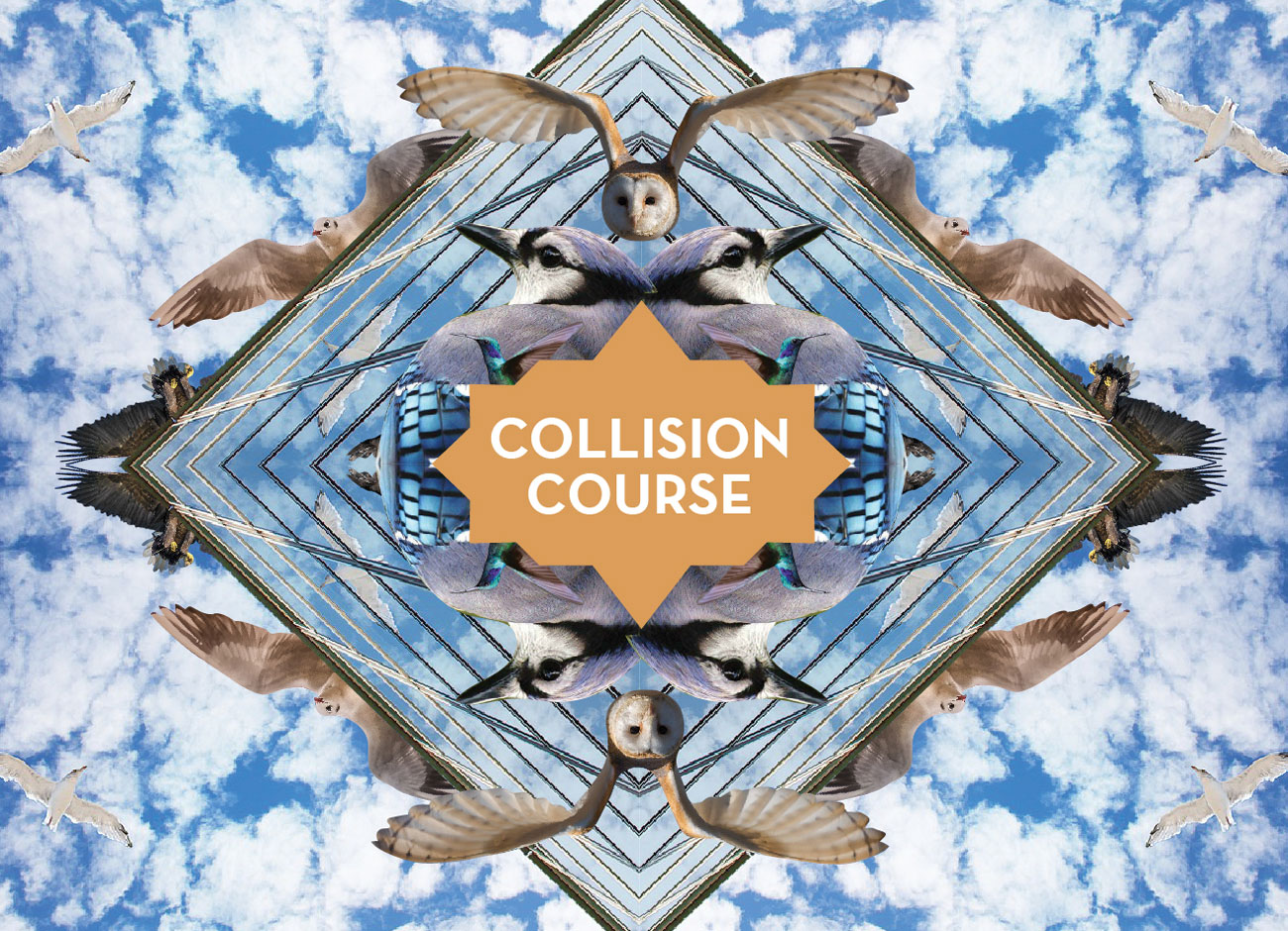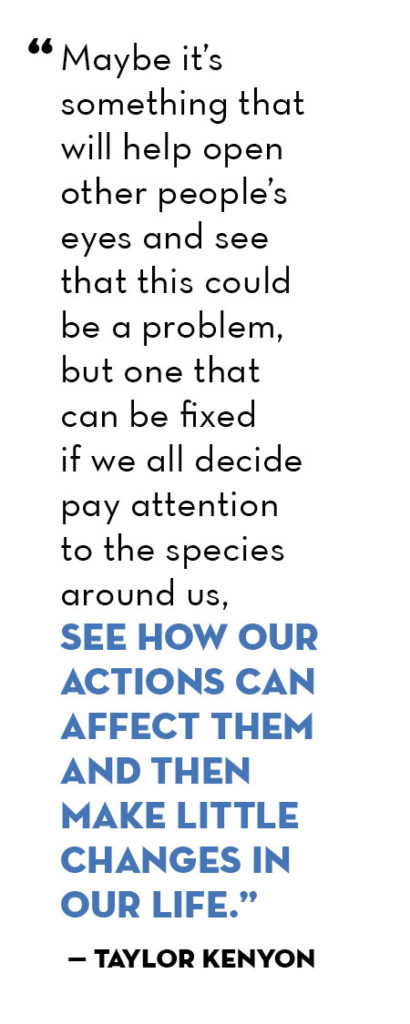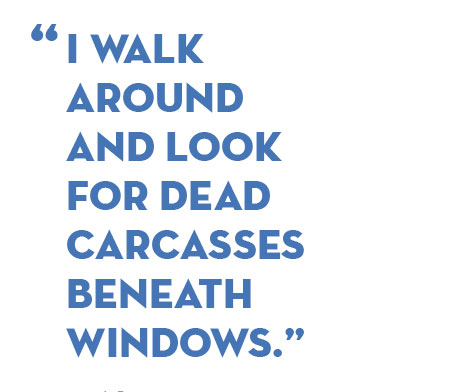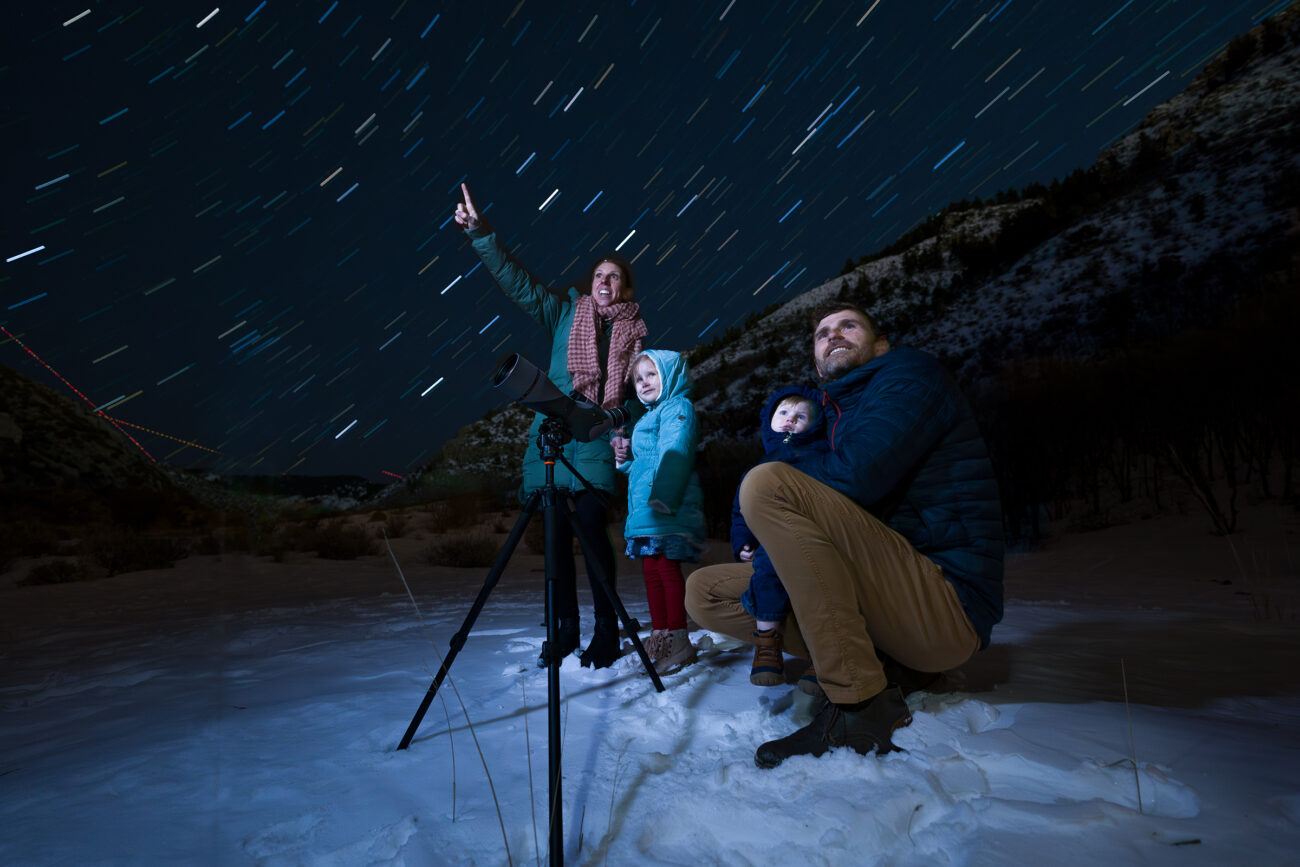Collision Course: Birds and the Built Environment

Growing up in Oregon, Taylor Kenyon can remember numerous times sitting with her family in their home in the Pacific Northwest, only to have a quiet moment abruptly interrupted by a “massive bang.”
“It actually used to happen a lot,” Kenyon says of birds colliding with one of the house’s windows. “We were so little, so it would scare us, and we’d all scream. But I always remember wondering why that happened so much. I thought that birds must just be so dumb.”
Curious by nature as a child, Kenyon says, “I never wanted to do like little-girl things,” she notes. “I wanted to do kitchen explosions and stuff, and I was always coming up with hypotheses.” But while she really wanted to know why birds would were so prone to making an often-fatal mistake like crashing into a window, young Kenyon was never able to get a satisfactory answer from friends or relatives.
But when she was a teenager, Kenyon’s family moved to the eastern plains of Colorado. Over time, Taylor came to realize that birds were no longer flying into the windows of her home in the wide-open spaces north of Denver.
“I realized that had lived in a very wooded area (in Oregon), and one of the reason people believe birds hit windows is because the window reflects trees,” explains Kenyon, a biology major at Utah State University who is now significantly more versed on the subject of bird-window collisions.
“When birds go to land on trees, sometimes they’re flying into that branch at 75 miles an hour,” she adds. “So, the reason why there’s such a loud boom is because that bird might be hitting that window at 75 miles an hour, which is why most of the time they end in a fatal collision.”
Fatal Reflection
Currently a sophomore focusing on ecology, Kenyon hopes to someday embark on a career as a marine biologist. But right now, she’s focused on researching bird-window collisions far from the ocean under the guidance of Jessica Habashi, a biologist and principal lecturer at USU Brigham City.
According to Habashi, in 2017, facilities worker Cyndi Peterson started to notice bird carcasses near the classroom and student services building, the 50,000-square-foot facility on south Main Street that opened in December 2015. Knowing that USU biology professor Kim Sullivan had orchestrated research into bird-window collisions on the Logan campus in recent years, Peterson reached out to Sullivan and Habashi.
“Cyndi said, ‘I don’t know if we’ve got a problem here, but I just thought I would let you know that we’ve been seeing some birds,’” Habashi says. “And so I said, ‘I really don’t know if we’ve got a problem with our building or not, but the C&SS building has a lot of the features that would make you predict that you’re probably going to get some bird-window collisions: we’ve got the building lit from the inside at night; we’ve got all of the glass; and we’ve got the mirrored glass, so birds are going to see sky and clouds kind of reflected in the windows. And then we’ve got a big tree on the inside of that building that you can see clearly from the outside, as well as vegetation near the windows.

“So, it kind of made us think, ‘Are we contributing to a problem or not?’”
In a 2014 article in The Condor, a research journal published by the Cooper Ornithological Society, it was estimated that between 356 million and 988 million birds die in the United States each year due to collisions with buildings, and, in particular, collisions with glass on buildings. Only the loss or conversion of habitat is believed to be a more significant contributor to the death of birds in the country, far outpacing other factors such as wind turbines, vehicles, cats, electrocution, or poison.
Curious to know what kind of impact the C&SS building might be having on the mortality of birds in Brigham City, which is located directly east of the 80,000-acre Bear River Migratory Bird refuge, Habashi organized of a group of students in her Biology 1610 class to catalog the number of bird-window collisions.
Utilizing a survey method similar to what Sullivan and her students were using in Logan, Habashi’s group would circle the building, paying close attention to the windows, as well as the ground below, and looking for any signs of bird collisions.
“Basically, what they did was take a census of the building, paying close attention to anything within 6 feet below the windows, while also looking to see if there were any bird-shaped smudges,” she explains. “If there’s either a bird carcass or a bird-shaped smudge, we take that as evidence of a collision. If there’s a bird, the student picks it up and identifies the species and tries to age it. If it’s just a smudge, they’ll take pictures to document it.”
Habashi says that while she was pleased with the information the students were accumulating, because of the limitations of the school year, her research team was lacking a full year’s worth of data — most notably during the summer months. But as time went on, she discovered that there were a handful of students interested in going on to graduate school who were willing to participate in the bird survey year-round.
While a few of those students live in the Brigham City area, some of them, like Kenyon, Jacob Larkin, and Hunter Martin, volunteered their own time to drive from Logan once a week to survey the C&SS building’s perimeter. And that time and effort has translated into opportunities to share their research at a national level.
Kenyon, who joined Habashi’s project in the fall of 2020, had the idea to focus her efforts primarily on the age of birds who died after window collisions, to try and determine if younger birds were more likely to have fatal crashes.
Larkin, a senior biology major, also began researching bird collisions in the fall of 2020, but took a broader approach to the potential problem “rather than looking to see if there’s an age factor or seasonality to it,” he explains. “And if there was a bird problem at the C&SS building, what we could do in the way of mitigation efforts.”
Larkin presented a poster of his findings at several different symposiums, including a virtual presentation at the 2021 meeting of the Ecological Society of America. It included research from surveys conducted outside of the C&SS building five days a week from August 2020 to November 2020, and seven days a week from November 2020 to August 2021. And while the number of fatal collisions dropped off significantly from the earlier 2017-18 surveys, nearly 69% of recorded collisions happened on the east side of the building.
Ultimately, however, Larkin concluded that the number of fatal bird-window collisions with the C&SS building fall within the expected monthly range for a low-rise non-residential building.
“It’s unfortunate for research implications — but a good thing for birds — that the C&SS building doesn’t really have a big problem when it comes to bird-window collisions, fatal ones at least,” Larkin says. “The average building of that size has about zero to six collisions for month, and I think the most collisions we ever found in a month was three. So, it really isn’t a big problem.”
The Possible Age Factor

As of early September 2021, the freezer in the biology department at the Brigham City campus contained the carcasses of about 25 birds that had likely collided with windows of the C&SS building. Kenyon is in charge of determining the age of all of the birds found on the Brigham City campus.
“At first, that was pretty hard, especially because I was aging the bird from the wrong side of the wing,” she admits. “But now I know what I’m looking for, and I can tell the difference between feathers that are more ruffled — an indication of a younger bird — and the well-maintained, smooth feathers of an adult.
“And I can also recognize the skull color easier. There’s actually a difference between if the bird’s skull is pink, which tends to be a younger bird, and when it’s gray, which is a more developed bird.”
Once the age of a bird is resolved, Kenyon notes how many of them appear to be in their hatching year versus those after their hatching year and those older than their second year of life. What Kenyon found during her initial research is that that more than half of the birds found following fatal collisions at the C&SS building were still in their hatching year.
Working in conjunction with Tadd Colver, a mathematics and statistics professor at USU Brigham City, the data recorded by Kenyon and her classmates underwent a goodness of fit test to try and determine how strong the evidence backed up her hypothesis that younger birds were more likely to collide with windows on campus. Ultimately, Colver came up with a p-value of 0.08, not a 0.05 or lower number that would have confirmed Kenyon’s hypothesis.
“A p-value of 0.05 would show there is a significant difference and that age does play a role,” Kenyon explains. “But because it’s a 0.08, it doesn’t suggest that there is a significant difference. There might be something there, it’s just that our sample size is so small that we can’t really tell for sure if there is a pattern there. But as we collect more and more birds, we’ll eventually be able to re-do the test.”
Kenyon’s hypothesis might inspire similar research regarding the age of birds involved in collisions at the USU campus in Logan.
“We haven’t done any official analyses yet, but we have noticed large numbers of juvenile birds hitting windows here,” Sullivan says. “It definitely seems there are more juveniles than adults. Juveniles tend to be less savvy about obstacles in their environment.”
Mitigation Efforts
Kim Sullivan admits that walking around the Logan campus with her might be a little different than taking a stroll with another USU professor.
“I look for a lot of blood spots,” she says. “I walk around and look for dead carcasses beneath windows.”
“I see problems,” Sullivan adds.
But she also sees solutions. And there’s little doubt that Sullivan has helped orchestrate significant changes that have helped to limit bird-window collisions now, as well as in the future.

Sullivan has taught biology at Utah State since 1988 and first became heavily involved in the bird-window collisions in Logan during the 2015-16 school year when about 40 cedar waxwings died after slamming into the large, reflective windows of the University Inn. That led to Sullivan initiating a student-led survey of buildings around campus in 2016-17 to discover the cause of such phenomena and then try to limit the number of collisions.
The researchers found that birds are more prone to crash into buildings with large window panes and/or windows they could see through, as well as places where trees were located within 5 to 10 meters of the window, particularly fruit-bearing trees. In addition to the University Inn, the Chase Fine Arts Center was of particular concern because of the ornamental pear trees directly outside the large windows fronting the art studios, as well as enclosed walkways, such as the one located between the Engineering Laboratory and the Science Engineering Research building.
“We had a very successful mitigation of the SER walkway, which has solar shades on it now, so you can see out, but the birds see it as dark and can’t see through it any longer,” Sullivan says. “We were getting a large number of robins that were hitting that walkway because they could see right through to the trees on the other side.”
The University Inn has proven a larger challenge because the mirrored-glass windows are only under warranty as long as nothing is put on them, so applying vinyl stickers to the glass isn’t an option. And the windows also open outward, negating the addition of screens. But Sullivan says the university is still looking at other options, which could include the use of ultraviolet patterns on the windows, which can make windows visible to certain species of birds while leaving the glass transparent to humans.
“But the cheapest way to do it is to build a building to avoid the problem,” notes Sullivan, who has had some success with having bird-window mitigation efforts considered a factor in new construction at USU, including the Sorenson Center for Clinical Excellence, as well as with the use of window decals and the placement of trees near buildings.
A mitigation strategy hasn’t been put together yet in Brigham City, but Sullivan and Habashi both believe that turning the lights off in the C&SS building late at night would help because there’s a large tree on the inside of the building that can clearly be seen from the outside. There’s also mirrored glass that reflects the sky and clouds, as well as vegetation near windows.
As for Kenyon, she says it’s been “cool to be a part of research project where you can see that there are possibilities to change.”
“Maybe it’s something that will help open other people’s eyes and see that this could be a problem, but one that can be fixed if we all decide pay attention to the species around us, see how our actions can affect them and then make little changes in our life.”
By Jeff Hunter ’96
Bird illustrations by Liz Lord ’04







John Swenson Harvey December 16, 2021
Interesting article about a problem that is both sad and somewhat intractable. Towards the end of my time at USU (79-87) we put stickers with hawk silhouettes on some buildings and pedestrian bridges, it was reported at the time that bird collisions/deaths were reduced. I’m glad to hear that efforts are still being made to reduce the number of collisions/deaths.